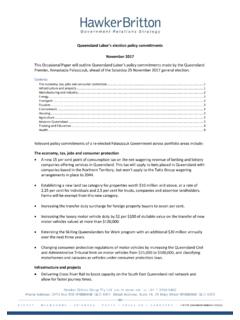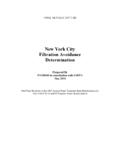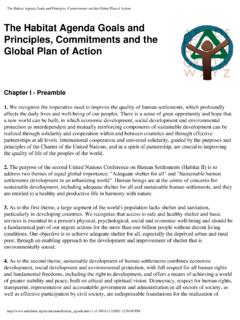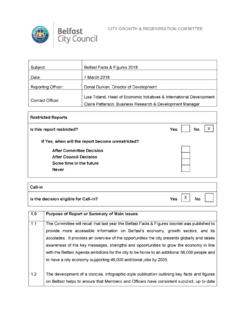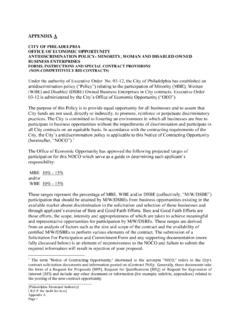Transcription of New York City Filtration Avoidance Determination …
1 2017 FAD New york city Filtration Avoidance Determination Prepared By New york State Department of Health in consultation with United States Environmental Protection Agency December 2017 2017 Surface Water Treatment Rule Determination for New york city s Catskill/Delaware Water Supply System 2017 FAD i Table of Contents Acronyms .. ii Executive Summary .. iv Background and Basis for Determination .. 1 SWTR Filtration Avoidance Criteria Requirements .. 17 Environmental Infrastructure Programs .. 21 Septic and Sewer Programs .. 21 New Sewage Treatment Infrastructure Program .. 26 Community Wastewater Management Program .. 27 Wastewater Treatment Plant Upgrade Program .. 30 Stormwater 31 Protection and Remediation Programs .. 33 Waterfowl Management Program .. 33 Land Acquisition Program.
2 35 Land Management Program .. 44 Watershed Agricultural Program .. 46 Watershed Forestry Program .. 50 Stream Management Program .. 52 Riparian Buffer Protection Program .. 60 Ecosystem Protection Program .. 64 East-of-Hudson Nonpoint Source Pollution Control Program .. 67 Kensico Water Quality Control Program .. 71 Catskill Turbidity Control .. 73 Sand and Salt Storage .. 78 Watershed Monitoring, Modeling, and GIS Programs .. 79 Watershed Monitoring Program .. 79 Multi-Tiered Water Quality Modeling Program .. 81 Geographic Information System Program .. 84 Regulatory Programs .. 86 Watershed Rules and Regulations and Other Enforcement/Project Review .. 86 Wastewater Treatment Plant Compliance and Inspection Program .. 89 Catskill/Delaware Filtration Plant Design .. 91 In- city Programs .. 93 Waterborne Disease Risk Assessment Program.
3 93 Cross Connection Control Program .. 95 Administration .. 96 Education and Outreach .. 99 101 2017 FAD ii Acronyms AOC Administrative Order on ConsentBMPs Best Management PracticesCAP CryptosporidiumAction PlanCATUEC Catskill AqueductUpper Effluent ChamberCDUV Catskill/Delaware Ultraviolet FacilityCCE Cornell Cooperative ExtensionCE CFI Conservation Easement Continuous Forest InventoryCFR Code of Federal RegulationsCREP Conservation Reserve Enhancement ProgramCSBI Catskill Streams Buffer InitiativeCT Concentration-Time (chlorine contact time)CWC Catskill Watershed CorporationDDBPR Disinfection and Disinfectant Byproducts RuleEOH East-of-HudsonEOHWC East-of-Hudson Watershed CorporationFAD Filtration Avoidance DeterminationFBO Flood Buy-OutFEMA Federal Emergency Management AgencyFIRMs Flood Insurance Rate MapsGIS Geographic Information SystemHAA5 Haloacetic Acids (sum of five)
4 IESWTR Interim Enhanced Surface Water Treatment RuleLAP Land Acquisition ProgramLFHMP Local Flood Hazard Management ProgramLT2 Long Term 2 Enhanced Surface Water Treatment Rule MAP Forestry Management Assistance ProgramMCL Maximum Contaminant LevelMGD Million Gallons per DayMOA New york city Watershed Memorandum of Agreement MOU Memorandum of UnderstandingNPS Nonpoint SourceNYC New york CityNYCDEP New york city Department of Environmental Protection NYCRR New york [State] Codes, Rules, and RegulationsNYS New york StateNYSDEC New york State Department of Environmental Conservation NYSDOH New york State Department of HealthO&M Operations and MaintenanceOST Operations Support ToolPFM PHL Precision Feed Management Public Health LawRWBT Rondout West Branch TunnelSAP Streamside Acquisition ProgramSDWA Safe Drinking Water ActSEQRA State Environmental Quality Review ActSOEM New york State Office of Emergency ManagementSMP Stream Management ProgramSMIP Stream Management Implementation Grant Program SPDES State Pollutant Discharge Elimination System 2017 FAD iii SWPPP Stormwater Pollution Prevention PlanSRP Septic Repair ProgramSWTR Surface Water Treatment RuleTAP Turbidity Action PlanTCR Total Coliform RuleTTHM Total TrihalomethanesUSEPA United States Environmental Protection AgencyUSGS Unites States Geological SurveyUV
5 UltravioletWAC Watershed Agricultural CouncilWAP Watershed Agricultural ProgramWDRAP Waterborne Disease Risk Assessment ProgramWECC Watershed Enforcement Coordination CommitteeWIG Watershed Inspector GeneralWFP Whole Farm PlanWOH West-of-HudsonWPS Wetlands Protection StrategyWR&Rs Watershed Rules and RegulationsWSP Water Supply PermitWWTP Wastewater Treatment PlantWQIP Water Quality Investment Program 2017 FAD iv 2017 Filtration Avoidance Determination Executive Summary Since 1993, New york city ( the city ) has met the requirements of the 1989 Surface Water Treatment Rule (SWTR) and, after 1998, the Interim Enhanced SWTR (IESWTR). This has allowed the city to avoid filtering its Catskill/Delaware water supply. The conditions that the city must meet to maintain Filtration Avoidance are described in the city s Filtration Avoidance Determination (FAD).
6 The first FAD was issued by the United States Environmental Protection Agency (USEPA) in 1993, with USEPA issuing subsequent FADs in 1997, 2002, and 2007. The 2007 FAD required the city to undertake a ten-year land acquisition program and included specific commitments to activities in other programs for the first five years. After the 2007 FAD was issued, USEPA transferred primacy for regulatory oversight of the city s FAD to the New york State Department of Health (NYSDOH). In May 2014, NYSDOH, in consultation with USEPA, issued the Revised 2007 FAD, which defined the city s requirements for the remaining period of the 2007 FAD. In accordance with NYSDOH s certification of the 2007 FAD, the next FAD was scheduled to be issued in 2017. This 2017 FAD supersedes the Revised 2007 FAD and will remain effective until a further Determination is made, currently scheduled for July 2027.
7 As the primacy agency, NYSDOH has authority to determine whether the city s Watershed program provides adequate protection of the city s water supply, pursuant to the SWTR/IESWTR and/or other Avoidance criteria in the SWTR/IESWTR. If NYSDOH were to determine that the city was not adequately protecting the Catskill/Delaware water supply, NYSDOH also has authority to require the city to filter the water from that water supply. 2017 FAD 1 Background and Basis for Determination As required under the Safe Drinking Water Act (SDWA) Amendments of 1986, USEPA promulgated the SWTR on June 29, 1989, specifying the criteria pursuant to which Filtration is required as a treatment technique for public water systems supplied by a surface water source. The SWTR is codified in the Code of Federal Regulations (CFR) at Subpart H of 40 CFR, Part 141 - National Primary Drinking Water Regulations.
8 The SWTR was promulgated to reduce the risk of waterborne disease occurrence from microbial contaminants at public water systems with surface water sources, either through Filtration or by meeting the stringent water quality, disinfection, and site-specific Avoidance criteria that make Filtration unnecessary. In response to requirements set forth in the 1996 Amendments to the SDWA, USEPA amended the SWTR on December 16, 1998 with the IESWTR, which is codified in Subpart P of 40 CFR, Part 141. USEPA amended the SWTR again on January 5, 2006 with the Long Term 2 Enhanced Surface Water Treatment Rule (LT2), which is codified in Subpart W of 40 CFR, Part 141. The IESWTR requires unfiltered systems to meet additional provisions to remain unfiltered, including compliance with more stringent disinfection byproduct maximum contaminant levels (MCLs) and the requirement to address Cryptosporidium in their watershed control programs.
9 The LT2 provisions for unfiltered systems are not specifically identified as requirements for Filtration Avoidance , but do require that unfiltered systems provide treatment for Cryptosporidium. The following sections of the SWTR (40 CFR and ) and the IESWTR (40 CFR ), define the criteria that must be met to maintain Filtration Avoidance . Applicable sections of Title 10 of the New york State Codes, Rules and Regulations (NYCRR), Subpart 5-1 are cited following the corresponding federal code citations. Source water quality conditions: (a)(1), (c)(1): Fecal or total coliform concentration requirements (a)(2), (c)(2): Turbidity level requirements Site-specific conditions: (b)(1)(i)/ (a)(1), (c)(3): Disinfection and CT requirements. (b)(1)(ii)/ (a)(2), (c)(4): Redundant disinfection components and auxiliary power supply requirements.
10 (b)(1)(iii) (a)(3), (c)(5): Entry point residual disinfectant concentration requirements. (b)(1)(iv)/ (a)(4), (c)(6): Distribution system residual disinfectant concentration requirements. (b)(2), (c)(7)(i)-(vii): Maintain a watershed control program which minimizes contamination by Giardia lamblia cysts and viruses. (b)(3) and (b): Be subject to an annual on-site inspection, which includes Determination of adequacy of the watershed protection 2017 FAD 2 program to limit potential contamination from Cryptosporidium. (b)(4), (c)(8): Must not be identified as a source of a waterborne disease outbreak. (b)(5), (c)(10): Must comply with the MCL for total coliforms in at least 11 of the 12 previous months (starting April 1, 2016, comply with MCL for Escherichia coli). (b)(6), (c)(9): Must comply with disinfection byproduct requirements (this provision of Subpart H was amended as part of the IESWTR).










